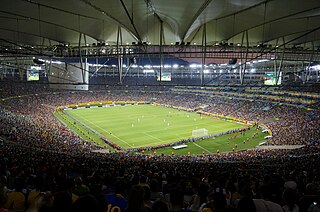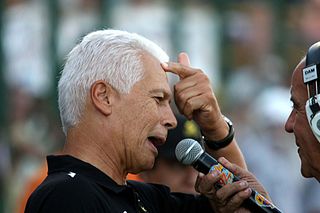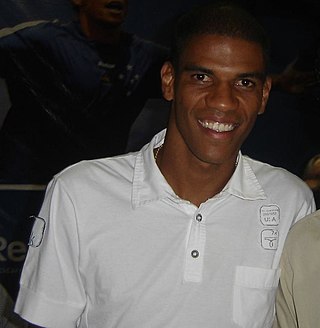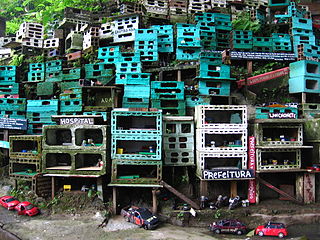
Copacabana is a bairro (neighbourhood) located in the South Zone of the city of Rio de Janeiro, Brazil. It is most prominently known for its 4 km (2.5 miles) balneario beach, which is one of the most famous in the world.

Rio de Janeiro, or simply Rio, is the capital of the state of the same name, Brazil's third most populous state, and the second most populous city in Brazil, after São Paulo. Listed by the GaWC as a beta global city, Rio de Janeiro is the sixth most populous city in the Americas. Part of the city has been designated as a World Heritage Site, named "Rio de Janeiro: Carioca Landscapes between the Mountain and the Sea", on 1 July 2012 as a Cultural Landscape.

The 1950 FIFA World Cup was the fourth edition of the FIFA World Cup, the quadrennial international football championship for senior men's national teams and held in Brazil from 24 June to 16 July 1950. The planned 1942 and 1946 World Cups were cancelled due to World War II. This tournament ended the hiatus. Uruguay, who had won the inaugural competition in 1930, defeated the host nation, Brazil, in the deciding match of the four-team group of the final round. This was the only tournament not decided by a one-match final. It was also the inaugural tournament where the trophy was referred to as the Jules Rimet Cup, to mark the 25th anniversary of Jules Rimet's presidency of FIFA.

Clube de Regatas do Flamengo, more commonly referred to as simply Flamengo, is a Brazilian sports club based in Rio de Janeiro, in the neighborhood of Gávea, best known for their professional football team that plays in Campeonato Brasileiro Série A, as well as Campeonato Carioca.

Fluminense Football Club, known as Fluminense, is a Brazilian sports club best known for its professional football team that competes in the Campeonato Brasileiro Série A, the first tier of Brazilian football and the Campeonato Carioca, the state league of Rio de Janeiro. The club is based in the neighbourhood of Laranjeiras since its foundation, in 1902. Fluminense is the oldest football club of Rio de Janeiro.

Club de Regatas Vasco da Gama, commonly referred as Vasco da Gama or simply Vasco, is a professional sports club based in Rio de Janeiro, Brazil. Originally a rowing club, Vasco is mostly known for its football team, who it currently competes in the Brasileirão Série A, the top tier of Brazilian football league and in the Cariocão Série A, the top tier of Rio de Janeiro state football league.

Maracanã Stadium, officially named Estádio Jornalista Mário Filho, is an association football stadium in Rio de Janeiro, Brazil. The stadium is part of a complex that includes an arena known by the name of Maracanãzinho, which means "The Little Maracanã" in Portuguese. Owned by the Rio de Janeiro state government, the stadium is now managed by the clubs Flamengo and Fluminense. It is located at the Maracanã neighborhood, named after the Rio Maracanã, a now canalized river in Rio de Janeiro.

Petrópolis, also known as The Imperial City, is a municipality in the Southeast Region of Brazil. It is located in the state of Rio de Janeiro, 68 kilometres (42 mi) northeast of the city of Rio de Janeiro. According to the 2010 National Brazilian Census, Petrópolis municipality had 295,917 inhabitants that year, up from 286,537 inhabitants at the last census. Besides being the largest and most populous city in the Fluminense Mountain Region, the city also has the largest GDP and HDI in the region.

Mário Jorge Lobo Zagallo is a Brazilian former professional football player, coordinator and manager, who played as a forward.

Guanabara Bay is an oceanic bay located in Southeast Brazil in the state of Rio de Janeiro. On its western shore lie the cities of Rio de Janeiro and Duque de Caxias, and on its eastern shore the cities of Niterói and São Gonçalo. Four other municipalities surround the bay's shores. Guanabara Bay is the second largest bay in area in Brazil, at 412 square kilometres (159 sq mi), with a perimeter of 143 kilometres (89 mi).

Émerson Leão is a Brazilian former footballer and manager. He is regarded by pundits as one of best Brazilian goalkeepers of all time. A documentary video produced by FIFA, FIFA Fever, called him the third-most impressive defense player of all time. He was born in Ribeirão Preto, São Paulo.

Armação dos Búzios, often referred to as just Búzios, is a resort town and a municipality located in the state of Rio de Janeiro, Brazil. It is 173 km east of the city of Rio de Janeiro. By 2020, its population consisted of 34,477 inhabitants and its area of 71 km2. Today, Búzios is a popular getaway from the city and a worldwide tourist site, especially among Brazilians and Argentinians.
Oswaldo de Oliveira Filho, known as Oswaldo de Oliveira, is a Brazilian football manager.

Rio das Flores is a municipality located in the Brazilian state of Rio de Janeiro. Its population was 9,344 (2020) and its area is 478 km².

Leonardo Fabiano Silva e Silva, commonly known as Leonardo Silva is a Brazilian former footballer who played as a central defender.

The 2013 FIFA Confederations Cup was the ninth FIFA Confederations Cup, which was held in Brazil from 15 to 30 June 2013 as a prelude to the 2014 FIFA World Cup. The most recent winners of the six continental championships appeared in the tournament, along with hosts Brazil and UEFA Euro 2012 runners-up Italy, who qualified because the Euro 2012 winners, Spain, had also won the most recent FIFA World Cup in 2010 thus securing a spot in the tournament.

Resende Futebol Clube, commonly known as Resende, is a Brazilian professional football club in Resende, Rio de Janeiro. The team compete in Campeonato Carioca, the top tier of the Rio de Janeiro state football league.

Project Morrinho is a social and cultural project based out of the Favelas Cariocas and the Favela (Pereirão) in the Laranjeiras neighborhood of Rio de Janeiro, Brazil. Morrinho, which was started by local youth in 1997, is a 450m² model of the city constructed from bricks and other recycled materials. It began as a simple childhood game to escape from the realities of violence and corruption that surrounded the teens and their community.

A series of floods and mudslides took place in January 2011 in several towns of the Mountainous Region, in the Brazilian state of Rio de Janeiro. Casualties occurred in the cities of Nova Friburgo, Teresópolis, Petrópolis, Bom Jardim, Sumidouro and São José do Vale do Rio Preto. The floods caused at least 916 deaths, including 424 in Nova Friburgo and 378 in Teresópolis. While local media claims that the combination of floods, mudslides and landslides in Rio de Janeiro became the worst weather-related natural disaster in Brazilian history, some contend that a similar weather-related tragedy that took place in the same state in 1967 was much deadlier, and that an estimated 1,700 people lost their lives on that occasion.


















